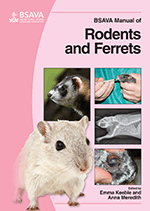
Full text loading...

Surgical magnification is very important because of the small patient size. Loss of relatively small volumes of blood can have serious consequences, including death. It is often not feasible to intubate them for anaesthesia and vital signs routinely monitored in larger patients (such as blood pressure and oxygen tension) often cannot be evaluated accurately in these small pets. Common conditions and techniques are detailed, such as Gonadectomy/neutering; Uterine diseases; Mammary glands; Enucleation and exenteration; Cystotomy; Tail degloving; and Everted cheek pouch.
Rodents: soft tissue surgery, Page 1 of 1
< Previous page | Next page > /docserver/preview/fulltext/10.22233/9781905319565/9781905319565.7-1.gif

Full text loading...














